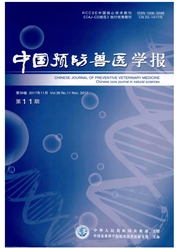

 中文摘要:
中文摘要:
猪小肠上皮细胞表面的产肠毒素大肠杆菌(ETEC)F4受体的基因型与其粘蛋白4(MUC4)基因密切相关,根据MUC4基因内含子7能否被限制性内切酶XbaⅠ酶切,可以在基因水平上将所检测的猪分为ETEC F4易感型纯合子SS,易感型杂合子SR和抵抗型RR。为筛选对ETEC F4受体易感性和抗性仔猪用于本实验室的后续实验,本实验利用MUC4基因的多态性,对送检猪的样品进行初步的分型检测。选取MUC4基因内含子7不同等位基因型的仔猪,分离其小肠上皮细胞,并分别与野生型F4ab、F4ac、F4ad大肠杆菌,表达fae操纵子的重组大肠杆菌r F4ab、r F4ac、r F4ad进行体外黏附和黏附抑制试验。研究结果表明,上述野生菌或重组菌对SS和SR两种基因型的4周龄断奶大白仔猪小肠上皮细胞均具有较好的黏附能力,而且经过抗F4单克隆抗体处理后的细胞,对细菌的黏附数明显下降。而RR型仔猪小肠上皮细胞不能黏附上述野生菌或重组菌。本研究为体外鉴定F4受体易感性仔猪,以及为进一步研究ETEC F4的致病机理奠定了基础和平台。
 英文摘要:
英文摘要:
Previous study shown that the porcine receptor of the fimbriae of enterotoxigenic Escherichia coli (ETEC) F4 is closely related to mucin4 (MUC4) gene. Based on the intron 7 of MUC4 gene with or without the Xba I enzyme site, pigs are divided into susceptible homozygote SS, susceptible heterozygote SR and resistant RR to F4 fimbriated ETEC. In this study, the porcine cell samples were collected and classified by the polymorphism of MUC4 gene intron 7. The intestinal epithelial cells (IECs) of piglets fi'om different phenotypes of F4 receptors were selected and incubated with wild type E.coli F4ab, F4ac, F4ad and recombinant E.coli strains carrying the fae operon gene clusters, designated as rF4ab, rF4ac, and rF4ad to be examined by adherence and adherence inhibition assays, respectively. The result shows that both the wild type and the recombinant strains were able to adhere onto IECsof 4-week weaned SS and SR pigs, and the number of bacterial adherence ratios decreased over 90% after treated the IECs with the monoclonal antibody against ETEC F4 fimbriae. However, the F4 fimbriated ETECs were unable to adhere onto the IECs from RR type piglets. This study lays a foundation for further study of the pathogenesis of ETEC F4.
 同期刊论文项目
同期刊论文项目
 同项目期刊论文
同项目期刊论文
 期刊信息
期刊信息
